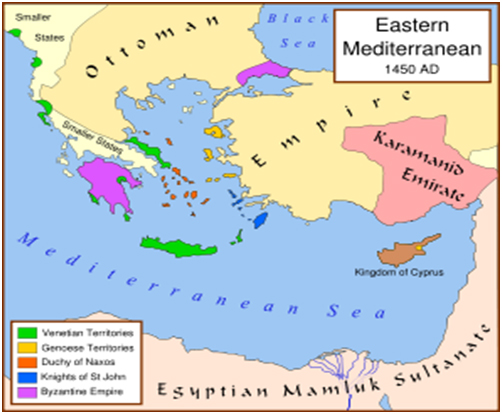2100 YEARS OR TRIBAL INVASION
400BC TO 1700AD
(See maps below how to use and where)
RISE OF THE OTTOMAN EMPIRE
The steady stream of Ottoman victories in the Balkans continued under Bavezidi (1389-1403). Bulgaria was taken and in 1396 a French-led Crusade that crossed the Danube from Hungary was annihilated at Nicopolios.
With cautious development, in 1420 the Ottoman power had recovered sufficiently to undertake fresh campaigns in Greece.
The Ottoman state originated as a Gazi Amirate. A clear cut distinction was never made between the civic and military functions of their government. The two basic functions of government were said to be the making of war and the collecting of taxes to support the making of war.
Each year the sultan carefully planned a campaign designed to achieve a particular objective – e.g. conquest of a new province, the reduction of a troublesome fortress or the suppression of a rebellion, within the time-period allotted.
Selim I and Suleyman the Magnificent
Ottoman expansion under Mehmed II’s successor, Bayezid (1481-1512) was mainly maritime in thrust. The Sultan’s new navy reinforced by corsairs displaced the naval powers of Venice and Genoa in the eastern and central Mediterranean. Selim the Grim extended Ottoman sovereignty south conquering Syria and Palestine. In 1517, he drove the last of the Mamluk Sultans from the throne in Cairo and made Egypt a satellite of the Ottoman Empire. Ottoman Sultans adopted the title of Caliph.
The long reign of Suleyman I was the Ottoman “golden age.” When he died in a campaign in Hungary in 1566 the Ottoman Empire was a major world power. Most of the great cities of Islam – Mecca, Medina, Jerusalem, Damascus, Cairo, Tunis and Baghdad were under the Sultan’s Crescent Flag.
The Porte (?) exercised direct control over Anatolia, the Balkan provinces, south to the Danube River, Syria, Palestine and Mesopotamia, Egypt, Mecca, and the north African provinces were governed under special regulations as were satellite domains in Arabia, in the Caucasus and among the Crimean Tartars. In addition, the native rulers of Wallachia, Moldavia, Transylyania and Ratgusa were vassals of the Sultan.

 |

